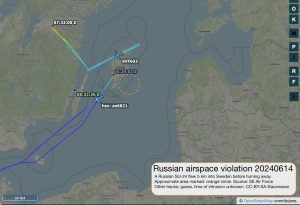[et_pb_section fb_built=”1″ admin_label=”section” _builder_version=”4.16″ global_colors_info=”{}”][et_pb_row admin_label=”row” _builder_version=”4.16″ background_size=”initial” background_position=”top_left” background_repeat=”repeat” global_colors_info=”{}”][et_pb_column type=”4_4″ _builder_version=”4.16″ custom_padding=”|||” global_colors_info=”{}” custom_padding__hover=”|||”][et_pb_text admin_label=”Text” _builder_version=”4.25.2″ background_size=”initial” background_position=”top_left” background_repeat=”repeat” hover_enabled=”0″ global_colors_info=”{}” sticky_enabled=”0″]
NATO’s Air Warriors Dominate Baltic Skies: On June 12, 2024, under the stern watch of a U.S. Air Force B-52 Stratofortress, a mixed armada of NATO fighters sliced through the Baltic skies, showcasing an ironclad unity. From left to right, Turkish F-16 Fighting Falcons, Spanish F-18 Hornets, a pair each of Spanish and U.S. Marine AV-8B Harriers, and Swedish JAS-39 Gripen fighters flew wing-to-wing. This high-octane flyover, part of Baltic Operations (BALTOPS) 24, demonstrated the tactical prowess and readiness of Naval Forces Europe-Africa, under the sharp execution of Naval Striking and Support Forces NATO. BALTOPS 24, a cornerstone maritime exercise in the region, sharpens the allied edge in safeguarding the vital sea lanes that stitch the Baltic nations together.
The 53rd annual Baltic Operations exercise, dubbed BALTOPS 24, kicked off on June 7 in the Baltic Sea, marking the largest such exercise in years. The exercise has roped in 20 NATO allies, marshaling over 50 ships, an armada of aircraft, and nearly 9,000 personnel dedicated to showcasing the alliance’s sea prowess.
Among the powerful fleet are two U.S. Navy amphibious ships, the USS Wasp (LHD 1) and USS New York (LPD 21), backed by a robust contingent of Marines. These forces are not just participating—they are demonstrating what it means to be at the sharp end of the spear in high-end warfighting exercises. The USS Wasp and its ARG, along with the 24th MEU (SOC), have surged into the U.S. Naval Forces Europe area of operations, proving their speed and agility in this dynamic security environment. The lineup also includes Arleigh Burke destroyers and the USS Mount Whitney command ship, currently anchored in Lithuanian waters.
This year’s BALTOPS also marks a milestone with Sweden stepping into the ring as a NATO member for the first time—an addition that has no doubt ruffled some feathers.
 While NATO was busy fortifying bonds and sharpening its readiness, the Russians decided to stir the pot. In a brash move, a Russian SU-24 bomber, looking more like a relic from a bygone era, brazenly breezed into Swedish airspace. Ignoring repeated warnings blasted over the radio, the aircraft penetrated about 3 miles into Sweden’s Gotland Island. It was only the swift intervention of Swedish fighters that turned the intruder back. The skies were tense, with several other Russian aircraft lurking nearby, according to Swedish Air Defense reports.
While NATO was busy fortifying bonds and sharpening its readiness, the Russians decided to stir the pot. In a brash move, a Russian SU-24 bomber, looking more like a relic from a bygone era, brazenly breezed into Swedish airspace. Ignoring repeated warnings blasted over the radio, the aircraft penetrated about 3 miles into Sweden’s Gotland Island. It was only the swift intervention of Swedish fighters that turned the intruder back. The skies were tense, with several other Russian aircraft lurking nearby, according to Swedish Air Defense reports.
As BALTOPS 24 continues through June 20, the chess game in the Baltic Sea evolves with each move, underlined by a stark display of NATO unity and a Russian penchant for brinkmanship.
[/et_pb_text][/et_pb_column][/et_pb_row][/et_pb_section]

